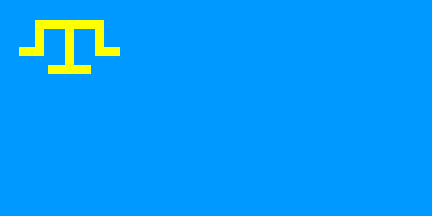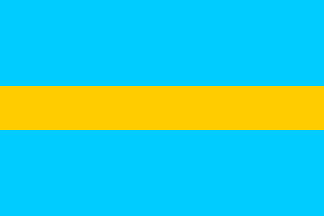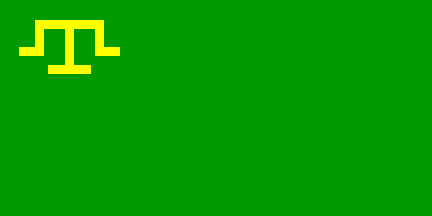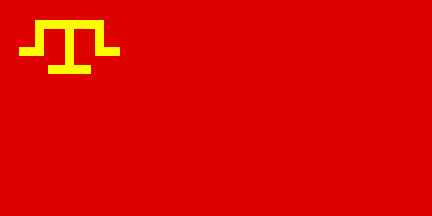
by Željko Heimer

Last modified: 2013-12-02 by andrew weeks
Keywords: crimea | ukraine | tarak | krym | tatar | tartar | tartary | tataria | republic of crimea | tamga |
Links: FOTW homepage |
search |
disclaimer and copyright |
write us |
mirrors
See also:
In 1944, Crimea's Tatar population was deported for
'disloyalty' during WW2. Although this decision was later
revoked, it was not until 1989 that the Tartars were legally
allowed to return to Crimea, where they now constitute around 8
per cent of the population. Tartar nationalists fly a light blue
flag with a yellow tarak in the upper hoist. (The tarak
is an ancient symbol originally used as a cattle brand).
Stuart Notholt
This flag is listed under number 97 at the chart "Flags
of Aspirant Peoples" [asp] as :
"Krim (Tatars) - Crimea peninsula."
Ivan Sache, 16 September 1999
A paper originally published in Izvestia (Moscow) and
translated in French in Courrier International (# 464, 23
September 1999) gives additional information about the history
and current status of Tatars in Crimea :
Status - On 17 May 1999, the Ukrainian president Leonid
Koutchma signed a decree creating a Council of Representants
of Crimea's Tatars at the Ukrainian presidency level. Mustapha
Djemiliev, the President of the Tatar parliament (Medjlis)
was appointed at the head of the Council. The Medjlis had been
elected by the traditional Tatar assembly (Kurultai) but had not
been officially recognized. On 24 May, the Prime Minister of
Crimea, Serguei Kounitsyne, promised to create a similar
structure at the Crimean level. These decisions followed weeks of
Tatar demonstration in Simferopol, which would elsewhere had been
controled by the Ukrainian Army.
History - Tatars colonized Crimea in 13th century. Between
1475 and 1775, Crimea was an independent khanat (capital
Bakhtchissarai). It was annexed by Russia in 1783 (proclamation
by Catherine II). During the Second World War, Crimea was
occupied by Germany from October 1941 to May 1944. The whole
Tatar community, ca. 400,000 peoples, were accusated to have
collaborated with the Germans and massively deported to Siberia
and Uzbekistan. On 14 November 1989, the Supreme Soviet of USSR
allowed the Tatars to come back in Crimea.
Claims - The Crimea's Tatars ask for:
- a status of autochtonous Ukrainian people
- an official status for Kurultai and Medjlis, as supreme
representative authorities
- an effective representation at all levels of political
organization
- a status of national language for their language
- the establishment of material conditions allowing the come-back
of all deported peoples
- the equality of rights of all peoples of Crimea regarding
privatization and emploiement
Other autochtonous peoples are Greeks, Germans, Bulgarians,
Armenians, Karaites (Jews) and of course Russians. The Tatar
question will be central in the next Ukrainian presidential
elections (autumn 1999).
More valuable info can be obtained at <www.euronet.nl>.
Courrier International shows a picture taken during
demonstrations in Simferopol. The flag shown (same as above),
although folded, is easily recognizable.
Ivan Sache, 27 September 1999
At <www.vatankirim.net>
there is a 2:3 and lighter version of the flag of Crimea's Tatars
and a consruction sheet for this flag.
Onur Özgün, 22 March 2004
See also: Tataria

by Antonio Martins, 12 January 2002 (reconstructed)
When Crimean Tatars declared independence in the end of 1917
they used a pale blue flag with a golden stripe/belt in the
middle (horizontal one I believe). Tatar independence in Crimea
was short-lived and Russian invasion in the beginning of 1918 put
an end to the Tatar Republic of Crimea and to the use of the
flag.
Mariusz Pazdziora, 7 October 1997

Religious flag
by Željko Heimer

Military flag
by Željko Heimer
The green flag is The Republic of the Tatars of Crimea -
religious flag. The flag was adopted november 1917, abolished
January 1918 (source: Jaumé Olle, Historical Flags,
1998).
Helge Jacobsen, 2 July 2000
The green flag with golden tamga was used by the Republic of
Crimea in later 1917-1918, under leadership of ethnic tatars. The
flags was in use for religious pourposes; light blue backgorund
with tamga was the state and civil flag; and red with tamga was
the military flag. Only light blue flag survived, and is now used
as ethnic flag of the Crimean Tatar. Tamga was used in canton and
in center. No regulation stablished the exact situation of the
Tamga in the flag
Jaume Olle', 10 July 2000